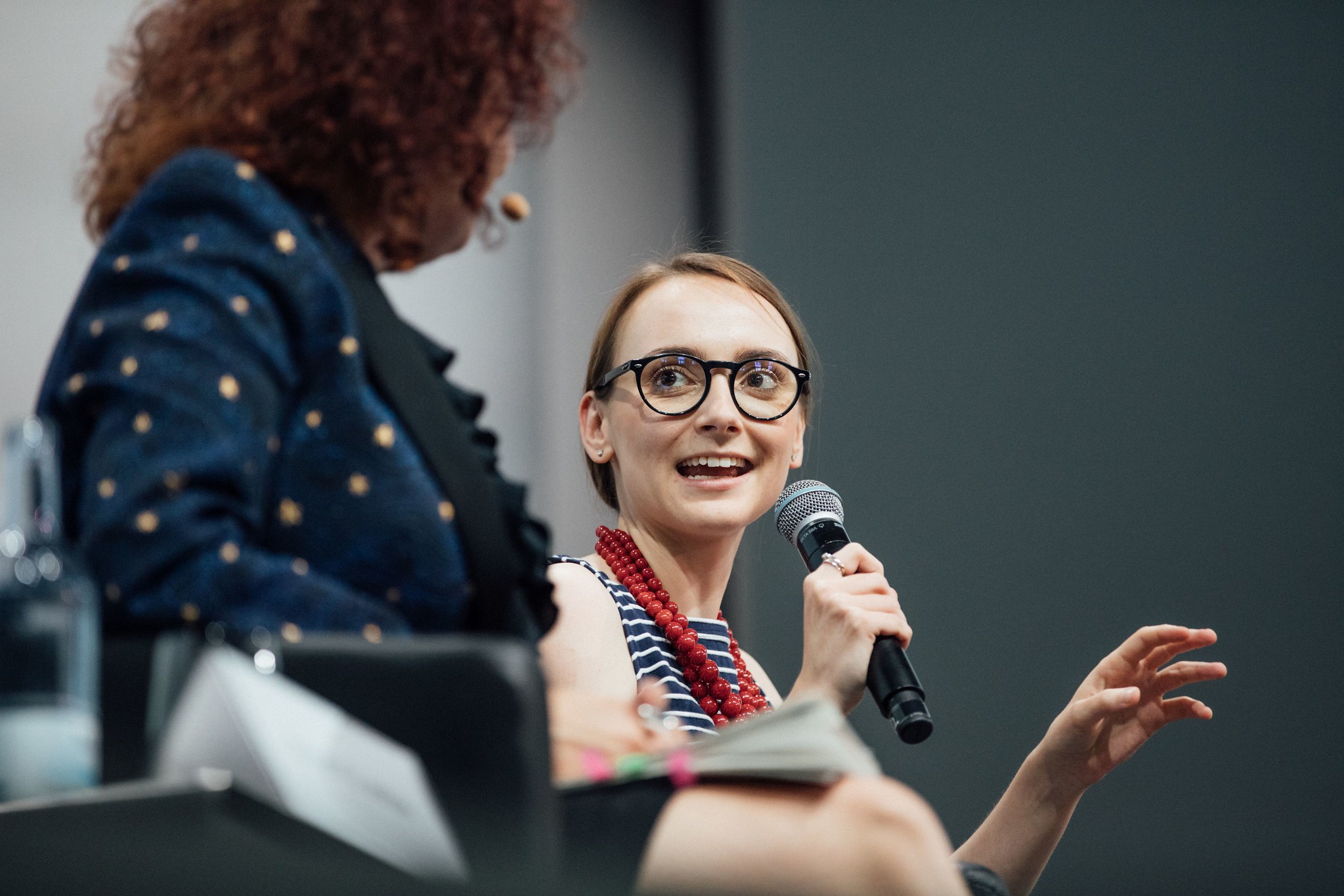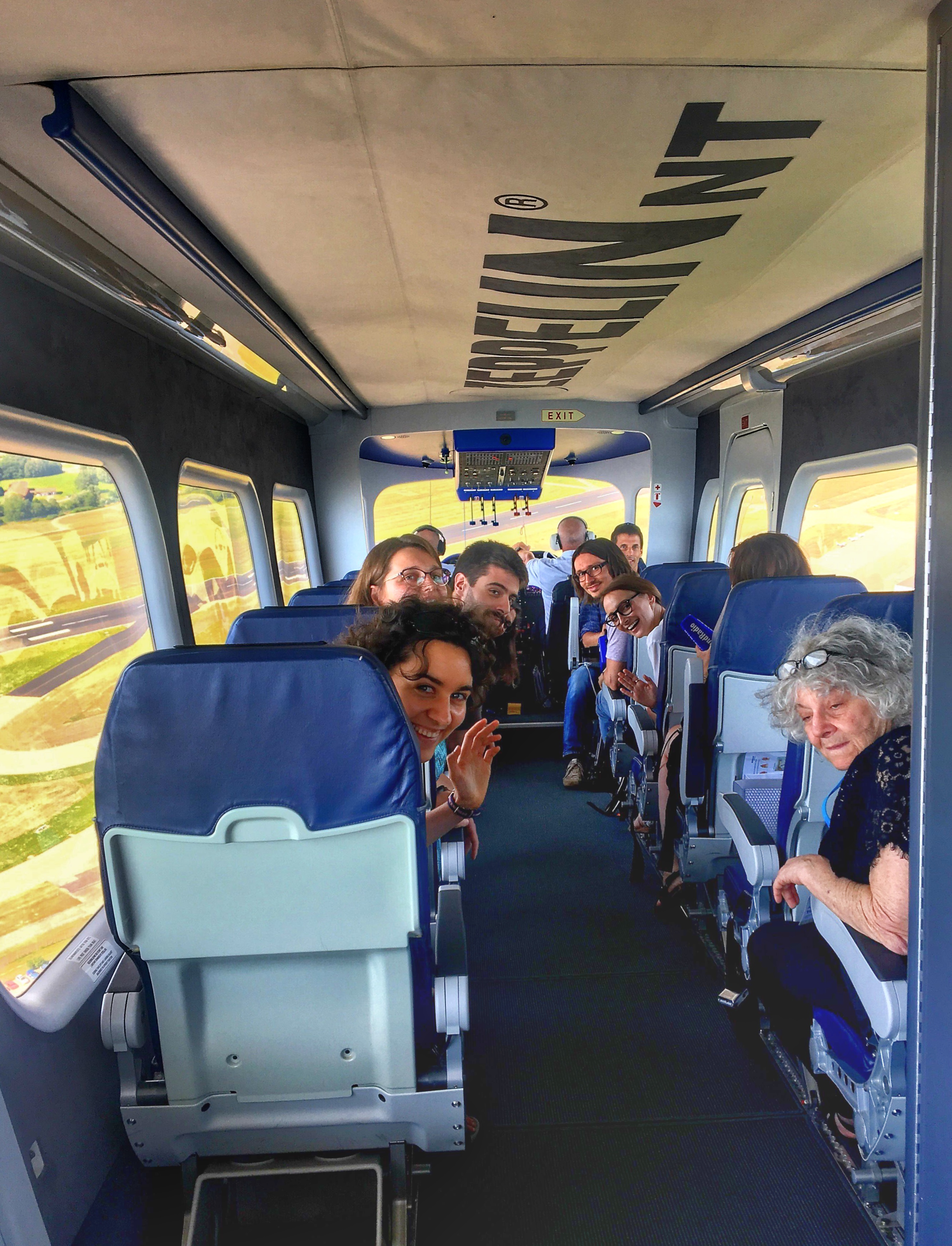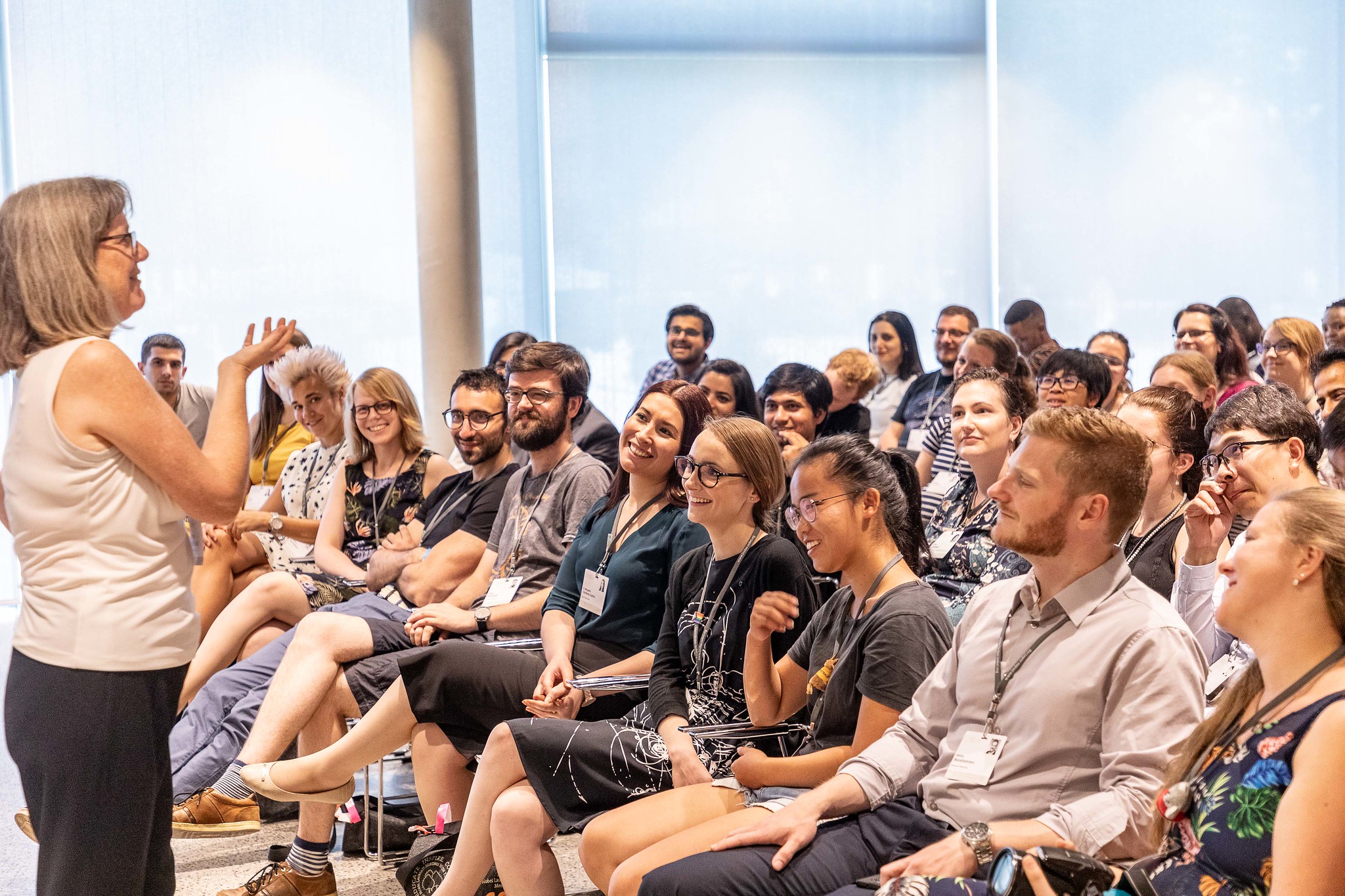
Maria Zurek, right, speaks during a discussion panel at the Linda Nobel Laureates Meeting. Panel moderator Alaina Levine is pictured at left. (Credit: Julia Nimke/Lindau Nobel Laureate Meetings)
Maria Żurek, a postdoctoral researcher in the Nuclear Science Division at the Department of Energy’s Lawrence Berkeley National Laboratory (Berkeley Lab), was invited to attend the 2019 Lindau Nobel Laureate Meeting in Lindau, Germany, in early July. The annual event offers networking opportunities for students, postdoctoral researchers, and Nobel laureates from around the world. A total of 580 researchers and 39 Nobel laureates from 89 countries attended this year’s meeting.
Originally from Poland, Żurek obtained her master’s degree in physics at Jagiellonian University in Krakow, which is one of the oldest universities in Europe. From there she joined the Juelich Research Center in Germany and received her Ph.D. from the University of Cologne. She is now serving in a three-year postdoctoral appointment in Berkeley Lab’s Nuclear Science Division.
Żurek shares her experiences at the conference in this Q&A – from a blimp flight with Ada E. Yonath, who won the Nobel Prize in Chemistry in 2009, to a panel discussion she participated in with three Nobel laureates about navigating a career path in science.
Q: How did you get invited to the Lindau Nobel Laureate Meeting?
A: I went through a two-stage application process. At the final stage the Lindau Foundation committee chooses the top 600 young scientists from around the world.
I learned about this conference when I was back in Germany, since my previous institution was one of the sponsors. I heard it’s a really amazing experience. The meeting’s topic alternates between physics, chemistry, and physiology and medicine. This year it was physics and most of the living Nobel laureates in this discipline were there, including George Smoot and Steven Chu from our area. It was my last chance to participate in the meeting in this topic, since the next one will be in four years, and to be eligible to apply you have to be under 35 and you cannot have a permanent position.
I started to apply in October last year, and I received the good news on my birthday in February that I was accepted. The Lindau Foundation puts a strong emphasis on scientific excellence and also on extracurricular activities, so I guess I got some extra points for my work as a co-chair of the Berkeley Lab Postdoc Association and my involvement in science outreach. Before the meeting, the organizers sent a media engagement survey, where you could write what activities you wanted to be involved in, including your ideas for posts for the official Lindau Meeting blog.
I knew I wanted to do more than just participate. If you are already there, why not use your chance to contribute in a meaningful way? I wrote an essay about careers in science, and after an interview with the moderator I was selected to contribute to a discussion panel with three Nobel laureates in physics.
Q: A blog post that you contributed for the Lindau Meeting explored your experiences with “imposter syndrome” – feelings of inadequacy that many people struggle with in their work. How have you coped with this in your career?
A: I’m still dealing with imposter syndrome and try to openly speak up when I doubt in my accomplishments. When I was there among young scientists at the meeting, I think the best moments were when people would say, “Thank you so much (for sharing this) – it really resonates with me.” It is a tough road and you have to be aware of it.
One thing that has helped me on this road are good mentors. One should build a mosaic of mentors inside and outside of your lab or group. These are the people who push you forward if you have moments of burnout and don’t know how to proceed. My role models also have moments of doubting in their accomplishments, and this showed me that I’m not alone in all of this. I know from my own experience that organized mentorship programs can also be very useful.
Of course, everyone has their own methods of dealing with imposter feelings. You learn to expect these moments when you are, for example, starting new projects or when presenting your talk at an important conference. It was a bit challenging to start talking openly about my feelings, but it simply helps to be open about it. And then when you see how many people are also facing the same problem it’s easier to deal with it.
The feedback about my blog post as well as the panel I participated in was extremely positive. What I really liked, too, is the discussion that happened afterward with other young scientists.
Q: What were other memorable highlights from the meeting?

Maria Zurek (middle, in right row of seats) participates in a blimp flight with Nobel Laureate Ada E. Yonath (bottom right). (Credit: Jolanda Schwarz)
A: There was something called “open exchange” that was an hour-and-a-half-long session in which you could choose a Nobel laureate and ask any questions you wanted. It was really nice – very casual.
Then there were more discussion sessions and panel sessions. There was a direct sign-up for taking part in various activities with Nobel laureates, such as science walks and science lunches. I had a chance to sign up for a zeppelin (blimp) flight. One of the scientific partners of the meeting was using zeppelins for measurements in ocean science, since they are very quiet and can fly at lower altitudes more easily than planes. We were over the Rhine. It was amazing.
It was great to chat with Ada Yonath. Her story is really amazing. Born in Jerusalem in a poor family, she lost her father when she was 11. To support her mother, she had to work odd jobs. She said that she was just curious about what was happening around her. And she stressed the importance of curiosity – being curious and following what you’re curious about.
There was a lecture by David Gross talking about the future of particle physics. He was giving an inspirational talk about the Standard Model of particle physics: This is what we know and what we don’t know, and this is how beautiful and simple this theory is, and it is open for extensions. In some ways it is really like magic, so beautiful and symmetric.
Q: What would you say to others who would like to apply to attend the Lindau Meeting?
A: When you are at a typical conference you tend to cluster with people you already know. But at this meeting there were so many people from so many different backgrounds – every area of physics you can imagine. The whole spectrum of people – it was great.
This is really the place where you have a unique opportunity to advocate for things that are extremely important in the scientific environment, and your voice can be heard because of the people who are there.
People who are influential in our field are in some ways on a pedestal. I think this meeting is an incredible opportunity because if an attendee advocates for something, there is a huge chance that their voice will be heard and things will actually change. Lots of topics were covered that were purely scientific, but there were also discussions about the importance of open science, of sharing freely, of science without borders – sharing knowledge between groups and working in big collaborations.
The discussion panel I participated in together with three Nobel laureates in physics – Donna Strickland, Bill D. Phillips, and Wolfgang Ketterle – covered the topic of aiming for a career in science. We discussed the importance of networking and mentoring, life-work balance in academia, and aiming for nonacademic career paths. Science needs its soldiers in every area, from science communication to industry. These are all crucial. I think that this has somehow motivated me to do one step more, to participate more actively.
The meeting convinced me even more that science is international. The only way we can push the boundaries of our knowledge as a society, and as humankind, is to work beyond our borders and strengthen and facilitate international collaborations, making every possible effort to ensure that our environment is diverse and inclusive.

Nobel Laureate Donna Strickland speaks during a session at the 2019 Lindau Nobel Laureate Meeting. Maria Żurek is seated in the first row, fourth from right. (Credit: Christian Flemming/Lindau Nobel Laureate Meetings)
Q: What brought you to Berkeley Lab and what do you enjoy about your work here?
A: What attracted me to Berkeley is the multinational environment of scientists, and the top quality of the science that is done here. I love working in national labs. I worked almost one year at Fermi National Accelerator Laboratory. I knew I would also be collaborating with Brookhaven National Laboratory while working here.
I study the structure of the proton and the origin of proton spin: the fundamental structure of matter we are made of. We know very well what the internal structure of protons looks like. They have quarks and gluons interacting with each other. But the question that’s still open is how, exactly, the spin arises out of this mess.
I always wanted to study either something that was extremely small, like particle physics, or something that was extremely large, like astrophysics, because these are things that are so mind-blowing and counterintuitive. I would like to see in my life the extension of the Standard Model. I’m pretty sure it will not be the work of a single person, but of huge collaborations. I wish to see this beautiful theory being completed in some sense.
The most important thing is to be driven by curiosity and fascinated by what you do, and to work in collaboration with professional, nice people in a healthy environment.
More:
- View the recorded panel session that Maria Żurek participated on with Nobel laureates Donna Strickland, Bill D. Phillips, and Wolfgang Ketterle: “Student, Postdoc, and Then? Aiming for a Career in Science.”
- View related blog posts in Physics World and the meeting blog about this panel discussion.
- View Żurek’s post about imposter syndrome and a related short video.
- View a video interview with Żurek by science comedian Brian Malow.
###
Founded in 1931 on the belief that the biggest scientific challenges are best addressed by teams, Lawrence Berkeley National Laboratory and its scientists have been recognized with 13 Nobel Prizes. Today, Berkeley Lab researchers develop sustainable energy and environmental solutions, create useful new materials, advance the frontiers of computing, and probe the mysteries of life, matter, and the universe. Scientists from around the world rely on the Lab’s facilities for their own discovery science. Berkeley Lab is a multiprogram national laboratory, managed by the University of California for the U.S. Department of Energy’s Office of Science.
DOE’s Office of Science is the single largest supporter of basic research in the physical sciences in the United States, and is working to address some of the most pressing challenges of our time. For more information, please visit energy.gov/science.